For a 2 node network, I've written an agent named "sensor" which sends a datagram req from node A to node B continuously for 5 mintues with a delay of 10 seconds between every datagram. After simulation, with the generated trace.json file i am trying to plot the graph for the rtt of each datagram.
import json as js
import matplotlib.pyplot as plt
f = open('trace1.json',"r")
data = f.read()
obj = js.loads(data)
list1 = obj['events']
flag = False
bias = 0
for j in range(len(list1)):
eventobj = list1[j]
list2 = eventobj['events']
Dict = {}
timeList = []
T = 0
R = 0
for i in range(len(list2)):
if(flag == False):
bias = list2[0].get('time')
st = list2[i].get("stimulus")
if(st['sender'] == 'phy' and st['recipient'] == 'phy'):
if st['messageID'] in Dict:
if "response" in list2[i]:
res = list2[i].get("response")
if(res['clazz'] != 'org.arl.unet.phy.BadFrameNtf' and res['clazz'] == 'org.arl.unet.phy.RxFrameNtf'):
time1 = Dict[st['messageID']]
time2 = list2[i].get("time")
diff = abs(time1 - time2)
timeList.append([(time1 - bias)/1000,diff/1000])
R = R+1
else:
if "response" in list2[i]:
res = list2[i].get("response")
if (res['clazz'] == 'org.arl.unet.phy.TxFrameNtf' and st['clazz'] == 'org.arl.unet.sim.HalfDuplexModem$TX'):
Dict[st['messageID']]=(list2[i].get("time"))
T = T+1
print(timeList)
x = []
y = []
for i in timeList:
x.append(i[0])
y.append(i[1])
plt.plot(x,y)
plt.xlim(0,400)
plt.ylim(0.8,1.2)
plt.xlabel('Timeline in seconds')
plt.ylabel('delay in seconds')
plt.show()
And the graph looks like this:

By observing the graph, I am not able to understand that within in a simple 2 node network why there such delay variation can be seen for every alternate datagram?(And why for every alternate datagram the delay is less?)